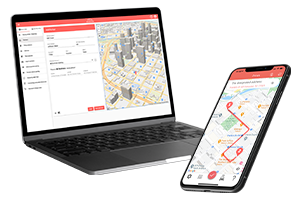May 10, 2024
Via Rideshare has carved out a unique niche in the bustling world of urban mobility. As a competitor to giants like Uber and Lyft, Via offers a distinct approach focused on carpooling and efficient city transit. This article dives deep into what it means to be a Via driver, exploring everything from the specifics of the service to the financial aspects of the job.

What is Via Rideshare?
Via is not just another rideshare company. Its business model is built around the idea of on-demand transit solutions, which aim to reduce congestion and make urban travel more sustainable. Unlike traditional rideshares that focus on individual rides, Via’s system groups riders together efficiently, setting it apart from the competition. Therefore, this system allows Via drivers to maximize their earnings while contributing to a greener city environment.
Via Drivers’ Rideshare Locations
The Via cab service operates in numerous cities across the globe, adapting its services to meet local needs and regulations. As of now, Via operates in several key locations across the United States, each with its unique set of regulations and requirements tailored to the local transit landscape. Here are the most prominent locations and their respective regulations Via drivers should keep in mind:
- New York City – In New York, Via tcab service drivers must comply with the Taxi and Limousine Commission (TLC) regulations, which include possessing a TLC driver’s license and operating a TLC-licensed vehicle. This ensures that all drivers meet the safety and insurance standards set by the city.
- Chicago – Via in Chicago offers both shared and private rides, adapting to the city’s diverse transportation needs. Drivers in Chicago are required to have a public chauffeur license and must pass a vehicle inspection that aligns with city regulations.
- Washington D.C. – Via partners with the District to supplement the existing public transit infrastructure, focusing on filling the gaps in less-served areas. Drivers in D.C. need a valid driver’s license from any state but must register their vehicle with the District Department of Transportation.
- Los Angeles – In Los Angeles, Via has focused on providing first-mile and last-mile connection services, linking with major public transit lines. LA drivers must have a California driver’s license and ensure their vehicle meets the state’s emissions standards.
- Seattle – Via’s operation in Seattle emphasizes connecting various neighborhoods to transit hubs, enhancing accessibility. Drivers in Seattle are required to hold a for-hire permit and vehicle endorsement issued by the city.
Joining Via as a Driver
The Via Driver App
The Via driver app is a cornerstone of the Via driving experience. It is designed to make the job as straightforward as possible. With features that help manage rides and schedules, the app supports drivers every step of the way. Tips for maximizing the app’s utility include accepting rides during peak hours and managing time efficiently through the app’s scheduling features.
A Guide to Via Driver Requirements
To become a Via taxi driver, applicants must meet specific criteria, which include a background check, a vehicle inspection, and adherence to local vehicle requirements. The application process is detailed yet user-friendly, ensuring that all potential drivers are well-informed of what Via expects and what they can expect in return.
How to Become a Via Driver
The journey to becoming a Via driver involves several key steps: submitting an application, passing a background check, and completing vehicle inspections. Additionally, Via provides training and orientation to prepare new drivers, ensuring they are ready to hit the road with confidence.
Navigating the Financial Aspects of Being a Via Driver
Via Driver Pay: Earnings and Compensation Structure
Via drivers often find that they can potentially earn more compared to those driving for Uber or Lyft, thanks to Via’s distinctive pay structure and more favorable commission rates. The amount a Via taxi driver earns can vary based on the city they operate in and how often they choose to drive.
Via’s payment model is particularly advantageous for drivers who handle multiple passengers per trip. This stands in contrast to Uber and Lyft, where earnings from shared rides might not be as lucrative as those from solo rides. This is because Via employs two primary compensation modes: Flex Mode and Blue Mode.
- In Flex Mode, drivers are paid based on the distance traveled and the time taken per trip, with the addition of surge pricing through Rocket Pay during peak times.
- Blue Mode, on the other hand, offers drivers a consistent hourly wage, irrespective of how many passengers they transport or the number of trips they make during that hour. This mode of payment provides a stable income, which is a significant deviation from the fluctuating earnings typical of Uber and Lyft.
Moreover, Via also enables passengers to tip their drivers directly through the app, which can significantly boost earnings for drivers who provide exceptional service. This feature adds an extra layer of financial incentive for drivers to excel in their customer interactions.
Taxes and Deductions for Via Drivers
Navigating the tax landscape as a Via driver involves understanding several key aspects, including what taxes need to be paid, how to pay them, and what deductions can be claimed to reduce taxable income.
Tax Obligations for Via Drivers
Via drivers, like all rideshare service drivers, are considered independent contractors. This classification affects how they are taxed. Independent contractors are responsible for their own federal and state income taxes, as well as self-employment taxes (Social Security and Medicare taxes). Instead of having taxes withheld by their employer, Via drivers must estimate their income and make quarterly estimated tax payments to the IRS and their respective state tax authority if their state has an income tax.
Process of Paying Taxes
To manage these obligations, drivers should calculate their estimated earnings for the year and make quarterly tax payments using IRS Form 1040-ES, “Estimated Tax for Individuals.” This form helps them figure out the amount to pay to avoid underpayment penalties. Each payment typically covers one quarter of the driver’s expected annual income, Social Security, and Medicare taxes.
Deductions Available to Via Drivers
Via drivers can reduce their taxable income by claiming deductions for various business-related expenses. Common deductions include:
- Vehicle expenses: Costs related to the operation and maintenance of the vehicle, such as gas, repairs, insurance, and depreciation.
- Mobile phone expenses: A portion of mobile phone bills can be deducted, provided the phone is used for business purposes like navigating rides or communicating with customers.
- Supplies and equipment: Any equipment needed for the job, such as car chargers, dash cams, or floor mats.
- Licenses and fees: Costs associated with maintaining a driver’s license, vehicle registration, and any required local permits.
Claiming Deductions
To claim these deductions, drivers must keep detailed records of their expenses throughout the year and report them on Schedule C (Form 1040), “Profit or Loss from Business.” It’s crucial to keep receipts and logs as proof of these expenditures in case of an IRS audit.
Maximizing Mileage Deductions for Via Drivers
Mileage deductions represent one of the most significant opportunities for Via drivers to reduce their tax burden.
What Drivers Need to Claim Mileage Deductions
To claim mileage deductions, Via drivers must keep a detailed log of all business-related vehicle expenses or miles driven for business purposes. This includes miles driven while looking for passengers, driving to pick up a passenger, and driving passengers to their destinations.
What Should Be Included in a Mileage Log
An IRS-compliant mileage log must include:
- The date of each driving session
- The starting and ending locations
- The total miles driven for business
- The purpose of each trip
Drivers can use a handwritten logbook or a spreadsheet to manually log miles (Excel and Google Sheets templates are quite popular). However, apps like MileageWise are popular choices because they automate tracking and categorize trips based on GPS data.
Download MileageWise’s automatic mileage tracker app from Google Play or the App Store & try it for free for 14 days. No credit card required!

MileageWise: Via drivers’ MileageTracker App
MileageWise is a specialized tool designed for gig workers and freelancers, offering a streamlined way to accurately track business mileage. With features that ensure compliance with IRS standards, MileageWise stands out for its exceptional customer support and unique capabilities, such as:
Energy-Efficient Automatic Tracking
MileageWise features an innovative automatic tracking system that captures only critical trip data, reducing the constant use of GPS. This method conserves battery life and enhances privacy by minimizing location data collection. This is possible, because the app efficiently calculates distances in the background, ensuring precision while safeguarding device performance and user privacy.
Built-in IRS Auditor
Integrated within MileageWise is a sophisticated IRS Auditor that meticulously verifies the accuracy of your mileage logs. Capable of identifying and rectifying up to 70 different types of discrepancies, this tool prepares your logs for IRS standards, substantially lowering the risk of issues during formal audits.
Automatic Trip Classification
MileageWise includes an Automatic Trip Classification feature that systematically categorizes trips as ‘business’ or ‘personal’ according to predefined rules. This automation simplifies the logging process and enhances record accuracy, which is vital for tax reporting and reimbursement processes.
Retrospective Mileage Log Creation
For users who haven’t kept real-time logs, MileageWise offers the capability to generate compliant and precise logs retroactively. Leveraging various data sources, including spreadsheets and Google Maps Timeline, this feature ensures you can reconstruct accurate logs for previously unrecorded trips.
AI Recommendation Wizard
The AI Recommendation Wizard in MileageWise utilizes historical driving data to optimize your mileage logs. It recommends the most tax-efficient routes and configurations, boosting your deductions and ensuring the logs align with actual odometer readings and tax records. This tool maximizes compliance and tax advantages.
FAQs
How Does Via Driver Work?
Via drivers use the Via app to connect with passengers who need rides. Unlike other rideshare platforms that focus on individual rides, Via emphasizes efficiency and sustainability through carpooling and on-demand transit solutions. Drivers log into the app, set their availability, and accept ride requests. The app’s algorithm smartly groups nearby passengers with similar destinations to optimize routes and increase earnings for drivers.
How to Become a Via Driver?
To become a Via driver, start by downloading the Via driver app and complete the application form. The process includes submitting personal information, a driver’s license, and other necessary documents. Applicants must pass a background check and have their vehicle inspected if they plan to use their own car for Via rides. Once approved, drivers receive training on the Via platform before starting to accept ride requests.
What Are Via’s Driver Requirements?
Via driver requirements vary by city due to local regulations. Generally, requirements include a valid driver’s license, a clean driving record, and passing a background check. Vehicles used for Via must meet specific standards, such as age, condition, and safety features. In some cities, additional licenses or permits may be required.
How Do Via Drivers Get Paid?
Via drivers earn based on a combination of factors including the number of trips, distance covered, and time spent driving passengers. Via offers two main pay modes: Flex Mode, where earnings are based on individual trip details and include potential surge pricing; and Blue Mode, which provides a steady hourly wage. Payments are made weekly directly to the driver’s bank account, and drivers can track their earnings through the Via app.
What Taxes do Via Drivers Need to Pay?
As independent contractors, Via drivers are responsible for their own federal and state income taxes, as well as self-employment taxes, which include Social Security and Medicare. Drivers must estimate their annual earnings and make quarterly estimated tax payments using IRS Form 1040-ES. They also have the opportunity to reduce their taxable income by deducting business-related expenses such as vehicle maintenance, fuel costs, and mobile phone expenses used for work.
How to Streamline Mileage Tracking for Via Drivers?
To streamline mileage tracking, Via drivers can use apps like MileageWise, which automatically tracks all business-related trips. These apps ensure accuracy and compliance with IRS requirements by logging each trip’s required details.
Download MileageWise’s automatic mileage tracker app from Google Play or the App Store & try it for free for 14 days. No credit card required!
| MileageWise | TripLog | MileIQ | Everlance | Driversnote | SherpaShare | Hurdlr | Excel | |
User Ratings (Trustpilot) | N/A | N/A | N/A | |||||
iOS App User Ratings | ||||||||
Android App User Ratings |
| |||||||
Average Possible Business Mileage Deduction | $12,000 | $6,300 | $8,400 | $6,500 | $6,000 | $5,600 | $5,600 | $200-$2,000 |
Imports Trips and locations from Google Timeline | ||||||||
Produces IRS-Proof Mileage Logs | ||||||||
Creates Retrospective Mileage Logs | ||||||||
AI Wizard Technology for Mileage Recovery | ||||||||
| Sampling / Recurring Daily Trips | ||||||||
| Mass Distance Calculation | ||||||||
| Built-In IRS Auditor for 70 Logical Conflicts Correction | ||||||||
| Web Dashboard | ||||||||
| Mileage Tracker App | ||||||||
| Vehicle Expense Tracker | ||||||||
| Manual Trip Recording | ||||||||
| Bluetooth Auto Tracking - with no hardware needed | ||||||||
| Plug'N'Go Auto Tracking | ||||||||
| Vehicle Movement Monitoring | ||||||||
| Battery and Data Friendly | ||||||||
| Other Software Integrations | ||||||||
| Trip List Import from other Mileage Trackers | ||||||||
| Trip List Import from GPS | ||||||||
| Shared Dashboard for Teams | ||||||||
Features are all related to mileage tracking | ||||||||
Pricing | Price list | Price list | Price list | Price list | Price list | Price list | Price list | Price list |



